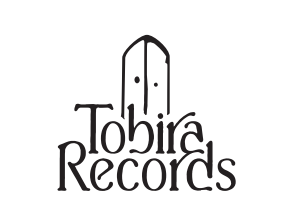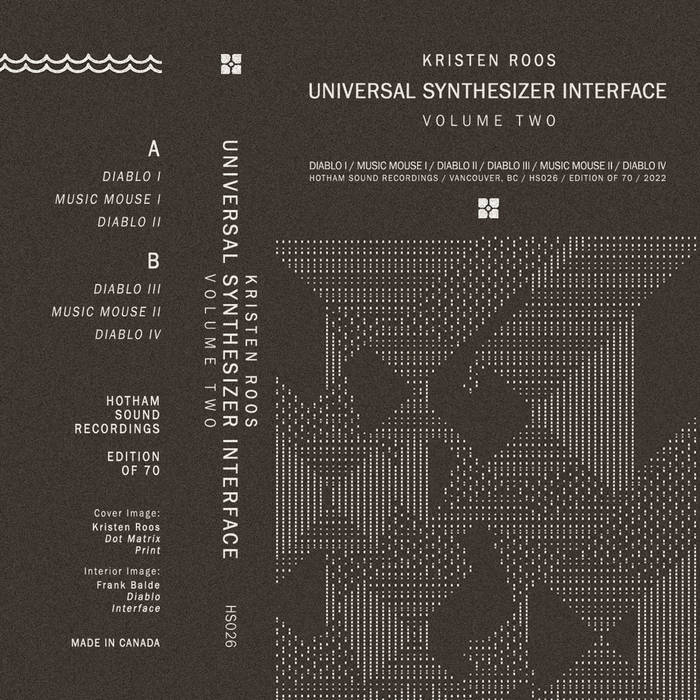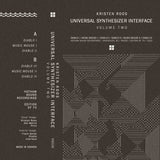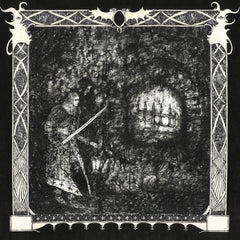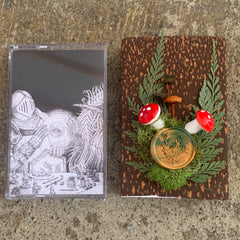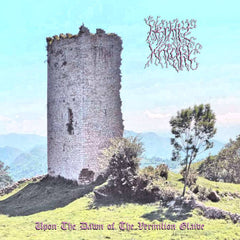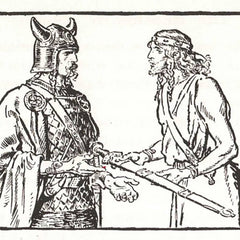Kristen Roos // Universal Synthesizer Interface Vol II 2xLP
- Availability:
IDM writer Kristen Roos from Vancouver, Canada, It is a reissued double-disc record released in June 2023 from Toronto's all-genre label, We Are Busy Bodies, with a limited edition of 6 copies. (original will be released on cassette in 500)
Post-new age ambient ~ IDM 80 songs produced using only 6's MIDI software. Comes with DL code.
Below is a commentary by Hothan Sounds, who released the original.
"Hotham Sound presents the long-awaited second volume in Kristen Roos' 'Universal Synthesizer Interface' series exploring the audio of early algorithmic MIDI sequencing programs for personal computers. In Vol.2 we introduced various vintage programs, but in Vol.1 Roos narrows down his personal favorites to two."Music Mouse" by Laurie Spiegel and "Diablo" by Franck Bardet.
One of the first "intelligent instruments" made for personal computers, Spiegel's "Music Mouse" was a surprisingly intuitive entry into the world of MIDI sequencing for many in the 1s. bottom.Control the placement and parameters of MIDI data with the mouse position, allowing users to quickly select and change the scale, chord voicing, and volume of their work on the fly.The keyboard is used as a control panel, and the digital "cheat sheet" that comes with the software outlines the various shortcuts.The program can only output four MIDI notes (which can then be arranged in short musical phrases or loops), but within this constraint is the enormous amount of capacity that creates musical variation and complexity. It has been done. Roos plays the software with a light touch, maintaining a delicate balance between playfulness and accuracy.
Franck Bardet's "Diablo" can literally "draw" MIDI data into a window much like early digital paint programs like MacPaint.Users can record data in loops, change note parameters (tonality, length, velocity, tempo, etc.), capture "snapshots" of their settings, and click in real-time.The program is limited to three loops at a time, but like Music Mouse, that limit hides an amazingly powerful tool for musical expression. In Roos' hands, repeating loops overlap and intertwine like patterns on a digital loom, slowly forming into a gigantic sonic tapestry. "
Labels and other worksplease use this form. ///Click here To See More HOTHAM Sound Recordings Releases Available at tobira.
--------------------------
Includes DL code. Edition of 500.
Hotham Sound Recordings:
"Hotham Sound is pleased to announce the much-anticipated second volume of Kristen Roos's'Universal Synthesizer Interface' series; an ongoing audio exploration of early algorithmic MIDI sequencing programs for personal computers. Where Vol I showcased a wide variety of vintage programs, Vol II sees Roos narrowing his focus down to two of his personal favorites: Laurie Spiegel's'Music Mouse' and Frank Balde's'Diablo.'
One of the first'intelligent instruments' ever created for the personal computer, Speigel's'Music Mouse' was, for many people in the 1980s, a remarkably intuitive introduction to the world of MIDI sequencing. Mouse position controls the placement and parameters of MIDI data The keyboard is used as a control panel, with various shortcuts outlined on a digital'cheat sheet' provided with the software. While the, allowing the user to quickly select and alter the scale, chord voicing and volume of their work on the fly. program is limited to outputting four separate MIDI notes (which can then be ordered into short musical phrases or loops) within these constraints lies an enormous capacity for musical variation and complexity. Roos plays the software with a light touch, maintaining a delicate balance between playfulness. and precision.
Frank Balde's 'Diablo' allows for MIDI data to be literally 'drawn' into a window very similar to early digital paint programs like MacPaint. , etc), and capture 'snapshots' of their settings that can then be clicked between in real time. The program is limited to three separate loops at a time, but like Music Mouse, its limitations conceal a surprisingly powerful tool for musical expression. In Roos's hands, the repeating loops overlap and intertwine with one another like patterns on a digital loom, slowly forming themselves into enormous tapestries of sound."
Artist: Kristen Roos
Label : We Are Busy Bodies
IDM writer Kristen Roos from Vancouver, Canada, It is a reissued double-disc record released in June 2023 from Toronto's all-genre label, We Are Busy Bodies, with a limited edition of 6 copies. (original will be released on cassette in 500)
Post-new age ambient ~ IDM 80 songs produced using only 6's MIDI software. Comes with DL code.
Below is a commentary by Hothan Sounds, who released the original.
"Hotham Sound presents the long-awaited second volume in Kristen Roos' 'Universal Synthesizer Interface' series exploring the audio of early algorithmic MIDI sequencing programs for personal computers. In Vol.2 we introduced various vintage programs, but in Vol.1 Roos narrows down his personal favorites to two."Music Mouse" by Laurie Spiegel and "Diablo" by Franck Bardet.
One of the first "intelligent instruments" made for personal computers, Spiegel's "Music Mouse" was a surprisingly intuitive entry into the world of MIDI sequencing for many in the 1s. bottom.Control the placement and parameters of MIDI data with the mouse position, allowing users to quickly select and change the scale, chord voicing, and volume of their work on the fly.The keyboard is used as a control panel, and the digital "cheat sheet" that comes with the software outlines the various shortcuts.The program can only output four MIDI notes (which can then be arranged in short musical phrases or loops), but within this constraint is the enormous amount of capacity that creates musical variation and complexity. It has been done. Roos plays the software with a light touch, maintaining a delicate balance between playfulness and accuracy.
Franck Bardet's "Diablo" can literally "draw" MIDI data into a window much like early digital paint programs like MacPaint.Users can record data in loops, change note parameters (tonality, length, velocity, tempo, etc.), capture "snapshots" of their settings, and click in real-time.The program is limited to three loops at a time, but like Music Mouse, that limit hides an amazingly powerful tool for musical expression. In Roos' hands, repeating loops overlap and intertwine like patterns on a digital loom, slowly forming into a gigantic sonic tapestry. "
Labels and other worksplease use this form. ///Click here To See More HOTHAM Sound Recordings Releases Available at tobira.
--------------------------
Includes DL code. Edition of 500.
Hotham Sound Recordings:
"Hotham Sound is pleased to announce the much-anticipated second volume of Kristen Roos's'Universal Synthesizer Interface' series; an ongoing audio exploration of early algorithmic MIDI sequencing programs for personal computers. Where Vol I showcased a wide variety of vintage programs, Vol II sees Roos narrowing his focus down to two of his personal favorites: Laurie Spiegel's'Music Mouse' and Frank Balde's'Diablo.'
One of the first'intelligent instruments' ever created for the personal computer, Speigel's'Music Mouse' was, for many people in the 1980s, a remarkably intuitive introduction to the world of MIDI sequencing. Mouse position controls the placement and parameters of MIDI data The keyboard is used as a control panel, with various shortcuts outlined on a digital'cheat sheet' provided with the software. While the, allowing the user to quickly select and alter the scale, chord voicing and volume of their work on the fly. program is limited to outputting four separate MIDI notes (which can then be ordered into short musical phrases or loops) within these constraints lies an enormous capacity for musical variation and complexity. Roos plays the software with a light touch, maintaining a delicate balance between playfulness. and precision.
Frank Balde's 'Diablo' allows for MIDI data to be literally 'drawn' into a window very similar to early digital paint programs like MacPaint. , etc), and capture 'snapshots' of their settings that can then be clicked between in real time. The program is limited to three separate loops at a time, but like Music Mouse, its limitations conceal a surprisingly powerful tool for musical expression. In Roos's hands, the repeating loops overlap and intertwine with one another like patterns on a digital loom, slowly forming themselves into enormous tapestries of sound."
Artist: Kristen Roos
Label : We Are Busy Bodies
